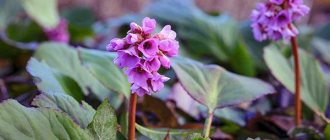History of occurrence: what kind of species is this?
Orchids have a history of 130 million years. Species Mix is a fairly young representative of this family . Phalaenopsis Mix is a native of the Asian tropics, which was adapted by breeders more than 100 years ago for growing indoors.
The second name, phalaenopsis, is translated from Greek as “moth-like.” It appeared thanks to the director of the European Botanical Garden, Karl Blume. It was he who brought the original flower, the ancestor of the Mix species, to his greenhouse in the 19th century, captivated by its resemblance to a butterfly.
Detailed description with photo
Mix is a perennial. The height of the stem is from 30 cm to 1 m. The appearance of the plant surprises with the variety of colors, from green to black-violet, the size of the flowers, the largest of which reach 15 cm, and their shape. These indicators vary depending on the variety.
What is the difference between Phalaenopsis mix and Phalaenopsis mini?
It must be recalled that Mix is plants of the same species , but of different colors and sizes. Mix mini is neither a hybrid nor a variety. This is the designation for the orchid brand . Therefore, it is inappropriate to compare different concepts.
Important! Mix is a group, and mini is a size.
The name “mini Mix” probably refers to a mini phalaenopsis of small size with the commercial prefix “mix”.
Bloom
With proper care, the orchid will bloom for a long time. Its dense flowers can delight you with continuous flowering for several months.
Attention! Flowering of large-flowered varieties is seasonal.
When and how do buds appear?
The average flowering period of phalaenopsis is 3 months. An adult plant blooms 3 times in a year . New branches with flower buds appear on the central shoot. Due to the gradual flowering, the plant is decorated with magnificent flowers most of the time.
Mature plants with large flowers have a flowering period from late autumn to summer.
Features of care before and after
Care before and after flowering is not much different.
Since the Mix orchid comes from the tropics, it needs moisture. The soil needs to be special, light and porous. But orchids are afraid of direct sun. After flowering, their peduncle is cut off . If the tip of the peduncle is green, it means the plant can still produce buds. Cut off the peduncle only after it has completely dried, leaving a stump of 2-3 cm.
What to do if it doesn't bloom?
It also happens that an orchid grows roots and leaves, but does not bloom. This happens if care is disrupted:
- Dry air.
- Irregular watering.
- Soil depletion.
In the first and second cases, it is enough to increase the humidity by spraying the flower and watering it. If there is a lack of nutrition, you will have to carry out mineral feeding .
Stimulation helps to start the flowering process:
- Trimming the peduncle will “awaken” the buds. The arrow is cut into approximately 3 buds.
- Place the plant in tropical conditions. Turn on the hot water in the bathroom so that it fills with steam. Place a flower pot there and water it with warm water for 15 minutes.
- Arrange temperature changes. You can take the orchid out to the balcony at night or leave it near an open window.
- Move to a more illuminated place.
Phalaenopsis mix
Extra
An even more attractive type of orchid for home growing. They are distinguished by a wide range of colors with various inclusions, multicolor and even more saturated color.
In popular scientific literature there are no names such as “mix” or “extra mix”. These are commercial names that give sellers the opportunity to somehow systematize a wide range of this amazing plant.
Photo of orchid mix extra.
Multifloral
It got its commercial name for its numerous flowers . Their number can reach up to 15 pieces simultaneously on each peduncle.
Particularly appreciated is cap flowering, when the flowers are collected in multi-flowered racemes.
They are characterized by long blooming and prolonged flowering.
Phalaenopsis multiflorum.
In nature
If we exclude the commercial component, when the name is given for systematization, and rely on the scientific one, then the Mix is plants of the same species, but of different colors . Accordingly, this species occurs in nature, since pollination occurs constantly.
Step-by-step instructions for care at home
Phalaenopsis Mix is not picky about care . However, it requires special growing conditions.
Selecting a location
The orchid will be most comfortable on a window facing east or west. The south window will have to be shaded so that direct sunlight does not burn the leaves. In the north, the orchid will wither from lack of light.
Preparing the soil and pot
Vigorous flowering occurs if a flower grows in a small pot . An additional requirement is transparency, since the roots also participate in photosynthesis.
A prerequisite is the presence of drainage holes. It is advisable that there are holes at the bottom for water drainage and on the walls for air circulation.
Because of this feature of the roots, the composition of the soil is also unusual. The orchid will not grow in ordinary garden soil . Roots, in addition to moisture and light, also require air. Therefore, the substrate for phalaenopsis consists of:
- coarse sand;
- peat;
- crushed bark;
- moss.
Special flowerpots and soil are sold in flower shops.
Temperature
Orchid loves warmth . In summer, the temperature for its comfortable maintenance is needed above 22°, in winter – 3° lower.
Attention! The orchid does not tolerate drafts.
Humidity
Phalaenopsis loves high humidity, but not high humidity. In summer it needs spraying only if the temperature is above +30°.
In winter, during the heating period, air humidity is low. An excellent option is to install an electronic humidifier .
If this is not possible, vessels with water are placed next to the pot, and wet towels are hung on heating appliances.
Illumination
The plant's need for daylight is high - 12 hours . In winter, it is compensated by additional lighting.
It is recommended to rotate the orchid relative to the light source for uniform development.
Watering
Wide leaves quickly evaporate moisture. Therefore, Phalaenopsis Mix should be watered 2 times a week during the growth period. Between flowering, watering is reduced.
Water with soft water at room temperature . It is recommended to do this in the morning so that the top of the substrate dries out by evening. Then the temperature difference will be slightly felt by the plant.
To understand whether it needs watering or is it too early, look at the pot. Condensation on the walls indicates a sufficient amount of moisture.
Light color of the roots will indicate the need for watering.
Attention! The soil under the plant should be watered. Make sure that water does not get into the axils of the leaves.
Tropicana orchid loves watering by immersion in water . They do it like this:
- Water is poured into a wide basin; if necessary, fertilizing can be added.
- The pot with the plant is placed in a basin so that three-quarters of it is in water.
- Leave for 10-30 minutes. The time depends on the volume of the pot, the age and size of the plant.
- Place the pot on a stand to drain excess moisture.
Abundant watering is required during flowering. If there is not enough moisture, the flowers will fall off.
Top dressing
Complex organic fertilizers have been developed for phalaenopsis . Their choice depends on the purpose of feeding:
- for development and growth, complexes with nitrogen and potassium will be needed;
- For lush and long-lasting flowering, the composition must contain phosphorus.
Regardless of the drug chosen, you should follow the basic feeding rules :
- Do not fertilize orchids that bloom profusely, as this will lead to the flowers falling off due to accelerated metabolism.
- Only healthy phalaenopsis are fertilized.
- Do not fertilize during or immediately after replanting the plant.
When feeding, be sure to act strictly according to the instructions for the drug!
Transfer
An orchid transplant is required immediately after purchase . This is due to the fact that in the store it is kept in a waterlogged substrate so that the plant is elastic.
Then, they are replanted once every 1.5-2 years. Do this carefully so as not to break off the fragile roots. Damaged or dry root areas are trimmed and sprinkled with charcoal.
Attention! A flowering plant cannot be replanted.
The pot is chosen a little larger than the previous one.
Growing problems
The leaves are turning yellow
Newcomers to growing orchids are often alarmed by yellowing leaves. There are many reasons and they are mainly associated with improperly created conditions and inadequate care.
Yellowed leaves.
The main ones:
- improper watering;
- diseases and pests;
- lack and malnutrition;
- error when using fertilizers and fertilizing;
- natural aging process;
- frostbite (open window in winter or transportation);
- fungal diseases.
The buds are drying
If the buds wither, then the reason should be sought primarily in poor lighting . In addition to lack of light, other reasons are possible:
- high room temperature;
- air humidity is too low;
- overdried or constantly wet substrate;
- drafts;
- sudden changes in temperature;
- problems with the root system.
The roots are rotting
Important! Even if most of the roots, or even all, have rotted, then there is no need to panic! Phalaenopsis mix is a very tenacious plant and, with proper resuscitation, can continue to amaze you with its flowering.
If 1-2 roots are damaged by rot, then this is not at all scary . To avoid the spread of rot, you need to cut them “at the living” spot and sprinkle the cut area with activated carbon or cinnamon.
Rotting of all roots is a very unpleasant moment. Even in this case, you can save the plant if you start resuscitation in time:
- it is necessary to cut off all the roots to the growing point. There is a chance to be revived, even if there is only one leaf left;
- Having cut off the roots, we check the growth point;
- areas damaged by rot are cleaned to a living (green) place;
- the places of cuts and stripping are sprinkled with crushed activated carbon or cinnamon.
Rotten roots.
We leave the phalaenopsis in this state to thoroughly dry the cut area. This process can take quite a long time, sometimes up to 5-7 days. During this period, the leaves may become lethargic and lose turgor, but you should not be alarmed. This happens due to lack of moisture. As soon as the roots appear, the plant will begin to recover.
As soon as the cut areas are dry, the phalaenopsis is placed over a container of water and every two days it is immersed in a solution of water with succinic acid for 10-15 minutes. This procedure will speed up the appearance of roots.
As soon as the roots grow to 5 cm, the orchid can be planted in the ground. You should know that the resuscitation process is quite long and can take up to six months.
How to propagate such a plant?
Many people want to propagate a flower - a butterfly. At home, it reproduces magnificently with the help of:
- Basal rosettes that grow on a plant. They are each planted in a separate pot in soil for orchids.
- Air babies - formed on peduncles. They are transplanted into the ground when each has its own roots.
- By dividing the stem , obtaining material for propagation by cutting off the top. The resulting cutting is placed in an orchid substrate and covered with a transparent cap. This method is also used to rejuvenate the plant.
Diseases and pests
Like other plants, the Mix orchid is susceptible to disease and pest attacks. It most often gets sick due to improper care. Timely measures will help rehabilitate the plant:
- Root rotting. It begins due to waterlogging, lack of nutrition, and lighting.
- Remove the flower from the pot.
- Trim damaged areas.
- Transplant into fresh substrate, into a new container.
- Place in a dark place.
- If dark spots appear , the flower is moved to a dark place to restore it.
- Leaves dry out in the following cases:
- The plant is old and needs updating.
- The influence of temperature changes.
- Incorrect watering.
Measures are taken depending on the specific reason. Insects can also damage the plant:
- Thrips . A sign of their presence is blue and silver inclusions on the orchid. The means of control is treatment with an insecticide.
- Spider mite . Signs: cobwebs on the undersides of leaves and yellow spots on the top. The remedy is washing with a soap-alkaline solution.
- Aphid . Signs: sticky stains all over the plant and a white coating. The means of control is a milky-water solution and a weak insecticide.
- Shield . Signs: scabs on the leaves, under which small insects are hiding. A means of control, as with aphids.
Transfer
If you decide to replant an orchid, do it only after the flowering period has ended. As a preparatory measure, purchase a transparent glass and a special substrate. As a rule, this is pine or pine bark.
The transplant is performed in the following sequence:
- First, wet the flower generously in the old pot to make it easy to remove.
- Inspect the root system of the orchids. If necessary, remove moss growths and yellowed root tips.
- All sections must be disinfected with crushed activated carbon. This is what you need to do with the roots.
- Now simply insert the orchid into a new pot and cover it with substrate. Tamp it down a little so that the plant is stable in the glass.











